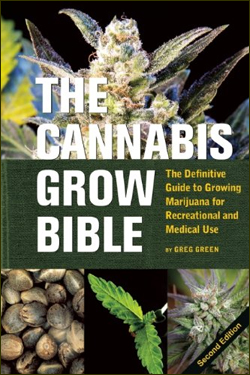
by Greg Green
Plant problems and how to solve them
Before we begin we should tell you what a chemical burn is. A chemical burn is what the plant suffers because of over-feeding. A chemical burn can be compared to a half-smoked joint. At the tip of the joint you have this shrivelled grey ash, in the middle you have the burn creeping towards new paper which leaves a pattern behind it, and then you have the part you have not smoked yet. A plant burn looks like this almost. The plant sucks up the water and the food. It distributes these elements to the leaves at the bottom first and then works it way up the plant. This process takes days to work as you know FROM WATERING and WHEN TO WATER! The damage starts at the tips of the leaf and slowly moves to the centre of the leaf, leaving behind it some crispy matter that flakes away between your fingers. This is what a chemical burn looks like. A nutrient problem does not look burnt. A nutrient problem looks like a cell collapse with discoloration. The part may wither and die, but it should not look burnt. That is major difference between a chemical burn and a nutrient problem. In time you should be able to tell the difference for yourself.
Also check your pH. If your pH is not right, then solve the pH problem before you go and do anything else.
A) Look at your problem and quickly search for any bugs. When you have completed this search, eliminate any bug problems by using the advice in the bug chapter. Also note the type of attack to make sure that it is not a bug problem AND is a nutrient problem, which can happen. Do your leaves look sucked and dry? Do you have any black dots on them like bugs? Try to tell the difference between a bug attack and a nutrient problem. Nutrient problems damage the plant on a somewhat consistent level. Bug attacks are less consistent in the damaged generated. They leave damaged patches everywhere on your plant.
If the problem seems to affects only the lower portion of your plant and or a bit of the middle then read B). If it is only effects the top of your plant and the tips then you should go to J). If the plant is covered with the problem then go to F).
B) If your plant is in vegetative growth and the leaves are going very yellow, then you need more Nitrogen. If your plant is in flowering and you have stunted growth, yellow leaves and it looks to be dying then you need more Nitrogen. If your plant is in flowering and does not look like it is dying but looks red or dark green/yellow then you need to treat it with more P, which is Phosphorus. If these do not help then go to C.
C) If your plant has leaves that are curling up, twisting and are going yellow then check to see if your light is burning them or if the grow chamber has enough air circulation. If this is fine then you need to consider adding more Mg which is Magnesium to your plants. Epsom salts are good – 1/4 – 1/3 table spoon of Epsom salts to 3 gallons of water is fine. If you still have a problem go to D).
D) If the tips of the leaves turn brown and curl slightly then you are looking at a K problem which is Potassium problem. If not, move onto E.
E) Does your plant look wilted? Maybe you over- watered? If not, go to F.
F) The veins are green, but the leaves are yellow. This is an Iron problem, Fe. If not, move on to G:)
G) Leaves are not twisted but are yellow at the base. The tips are fine. This is a Manganese problem, which is (Mn). If not, move on to H).
H) Still haven’t solved it? Then flush your soil and find another type of plant food that has all of these. N, P, K, Ca, Mg and S. Get Epsom Salts and get a small canister of micronutrient. Iron, boron, chlorine, manganese, copper, zinc, and molybdenum. Try using a nutrient mixture that we have already mentioned before in the indoor feeding section.

